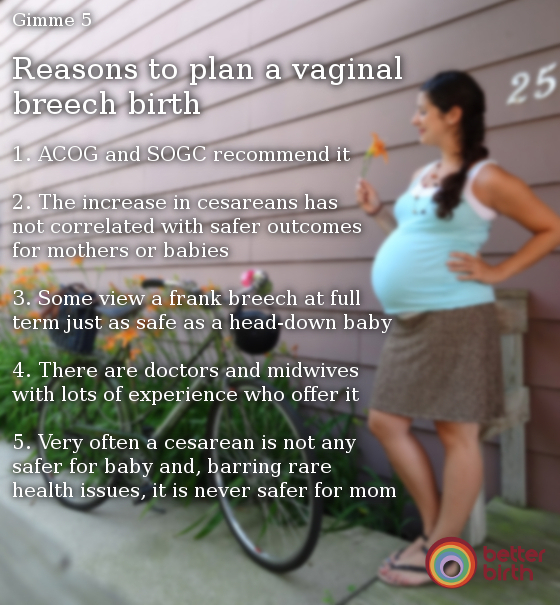
Can you have a natural birth with a breech baby?
It used to be that, when a baby was breech, women could choose between vaginal and cesarean birth. In 2001, a flawed study took away the option. It has since been debunked, and most everyone admits that it’s safest to offer vaginal breech birth for women with breech babies. Institutional change has been incredibly slow.
Recent studies show that vaginal breech birth is just as safe or safer than cesarean breech birth; there are risks with both. Some researchers say that if you have an appropriately sized pelvis, there is no increased risk for mom or child. Some breech positions (extended or frank breech) are more suited to vaginal birth than others.
Without regard to position, most obstetricians order an automatic c-section for a breech baby. Very few will agree to a trial of labor and even fewer will feel good and confident about doing it. Though there are some.
Among midwives and in general, a CNM is less likely to feel good about an out-of-hospital breech birth than a CPM. Many breech babies are born safely and without incident at home. Some are born unassisted (UC).
The foremost vaginal breech birth practitioners (doctors and midwives) tend to agree that it is a higher-risk birth and that having an experienced, confident caregiver is the best way to assure success. ACOG says that if elective cesarean is an option, in spite of its inherent dangers, so must elective vaginal delivery be an option. Your chances of finding this kind of care are largely a geographic lottery.
Check out the Breech Baby Handbook for complete, quick information.
Is vaginal breech delivery safe?
It seems that the evidence-based professionals who are reviewing studies and writing mostly say: Yes, though it depends.
1. Can you find a confident, skilled, experienced provider (doctor or midwife) to attend you? and
2. How many of the risk factors do you have?
If you have a provider or can get one and don’t have a risky position or additional complications, the short answer is that it has every likelihood of being safe.
In a recent study, researchers compared outcomes for planned cesarean and planned vaginal birth for breech babies among 8,105 women in France and Belgium. In the planned vaginal birth group, 71% were successful. No significant differences were noted in outcomes between the vaginal and cesarean groups.

“Routine cesarean delivery of the near-term or term breech fetus increases maternal morbidity, maternal mortality, and the cost to society, but it does not provide a foreseeable benefit to the near-term and term breech fetus….Although preached with great emotion, the recommendation for routine elective cesarean section to deliver the near-term or term breech fetus cannot be substantiated by studies published over the last decade.”
-C.P. Weiner, Journal of Clinical Obstetrics and Gynecology
The problem is that so few people have the skills.
|
I find it sad that obstetrics has been so dumbed down in the US that few doctors are taught anymore how to deal with a vaginal breech birth. They especially fear the case in which the baby’s feet present before its head. The very prospect frightens many because they have never witnessed a breech birth. …What astounded me was the speed of the change in the very content of the obstetrics curriculum. When I learned that the reason for such a change was insurance companies that began threatening teaching hospitals during the seventies and eighties that they would deny them malpractice coverage if they provided opportunities for residents to witness a breech birth attended by an experienced practitioner, I had to wonder if doctors of the future would ever regain such skills. …. I know of at least two maternal deaths that happened in recent years in the US because of fear and ignorance surrounding vaginal breech birth. In both cases, the physician chose a C-section because of presentation. In one case, the mother died from hemorrhage during the emergency C-section performed for her second twin, whose feet presented, along with the umbilical cord, after her first baby had been vaginally born. This is the one case of umbilical cord prolapse that it NOT dangerous, because it doesn’t pinch the cord between the baby’s body and that of the mother, and a footling breech born with “the door already open” should be easily accomplished if the doctor or midwife is not petrified with fear. In effect, a mother of eight died because of ignorance that was imposed on her doctor by the insurance company. I find this intolerable. p.114-115 |
.
Here is great, short documentary about breech birth.




